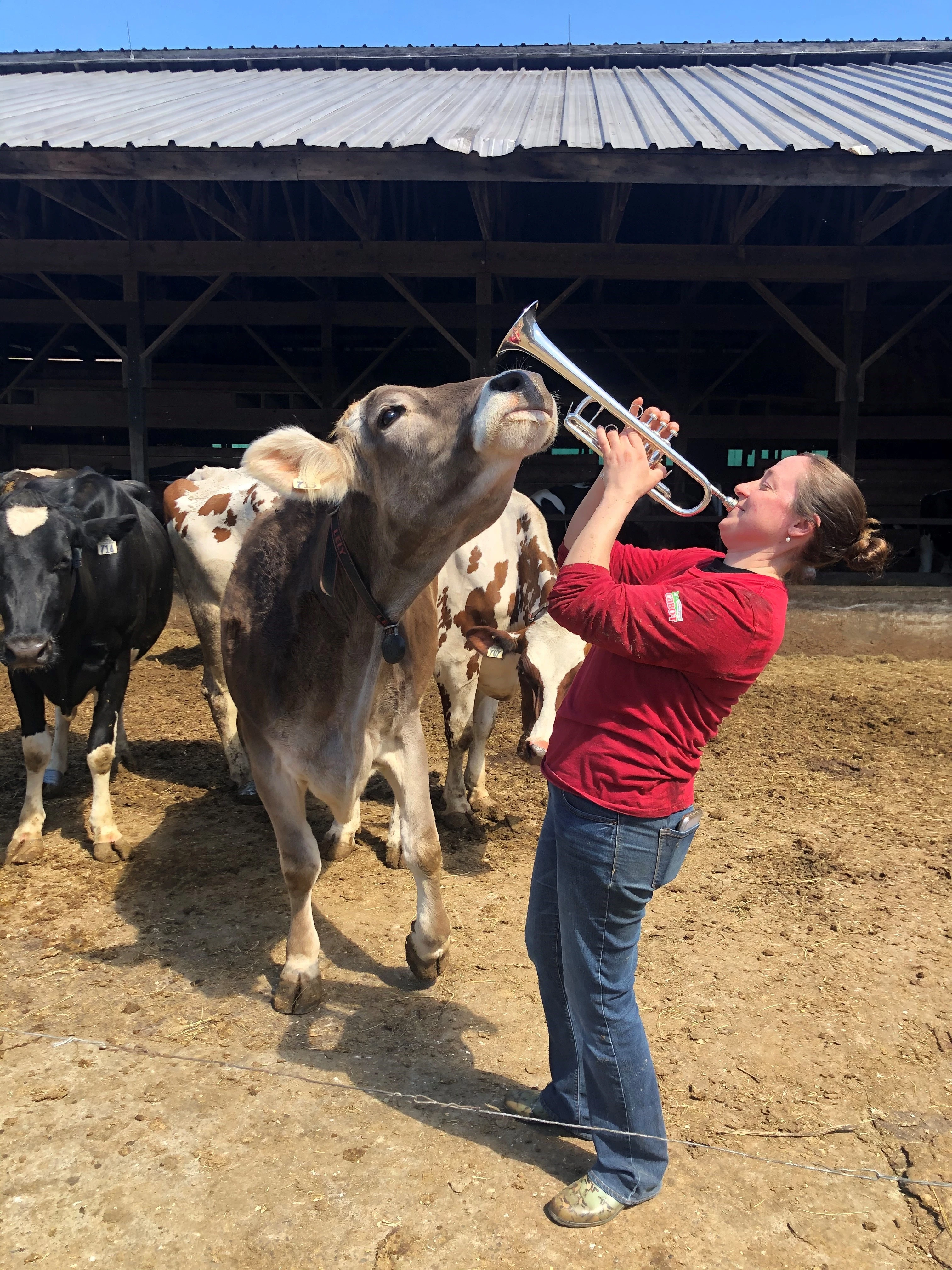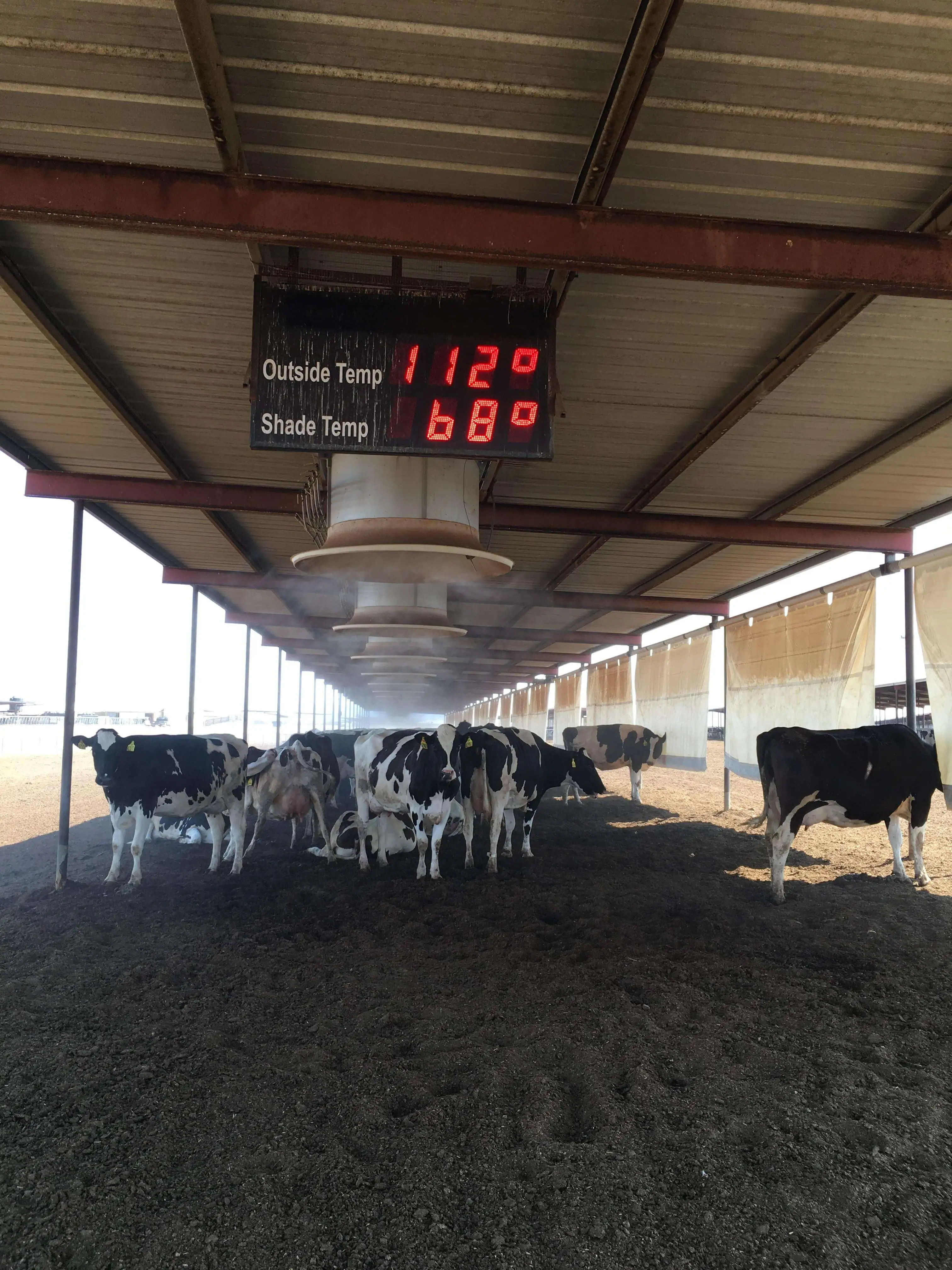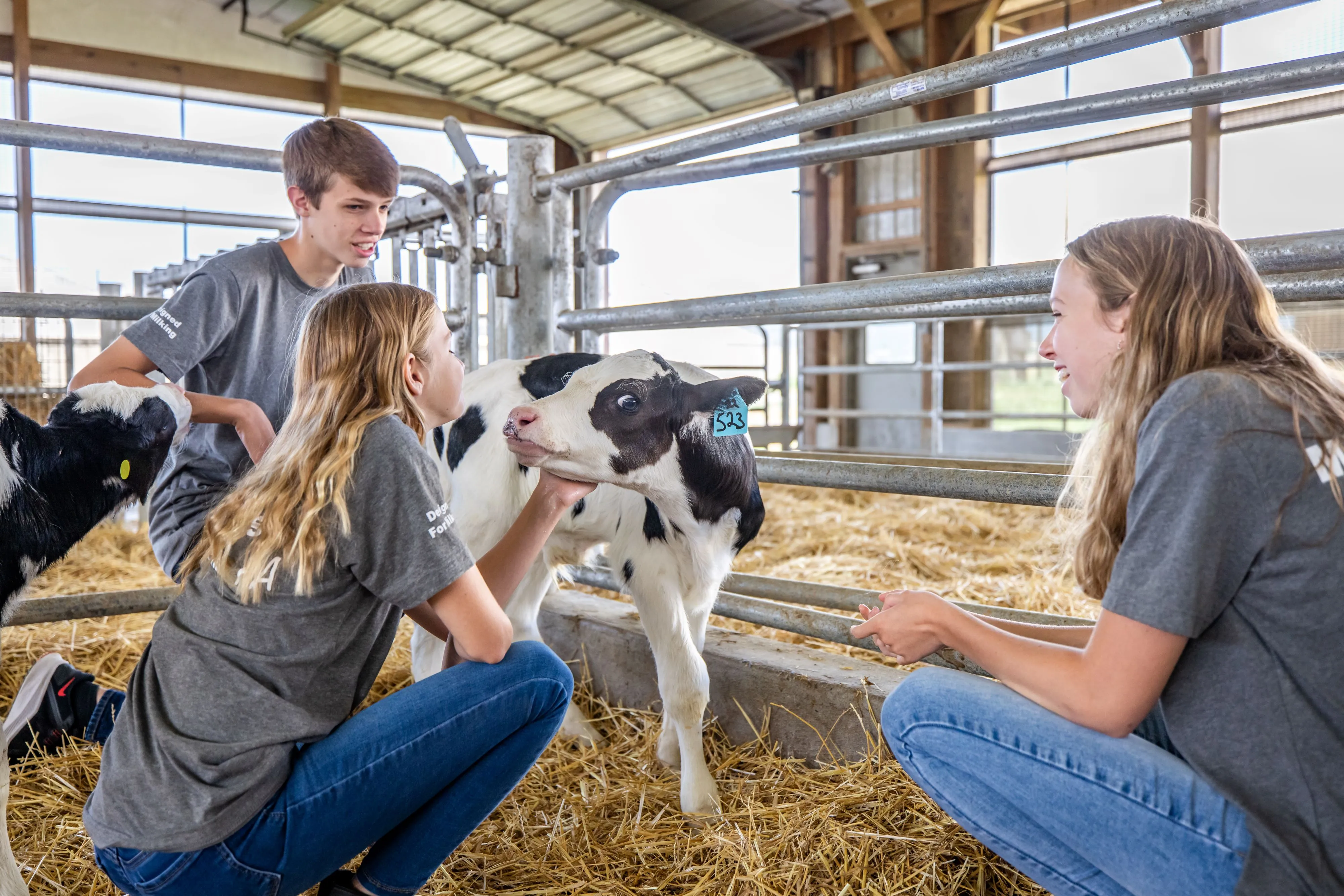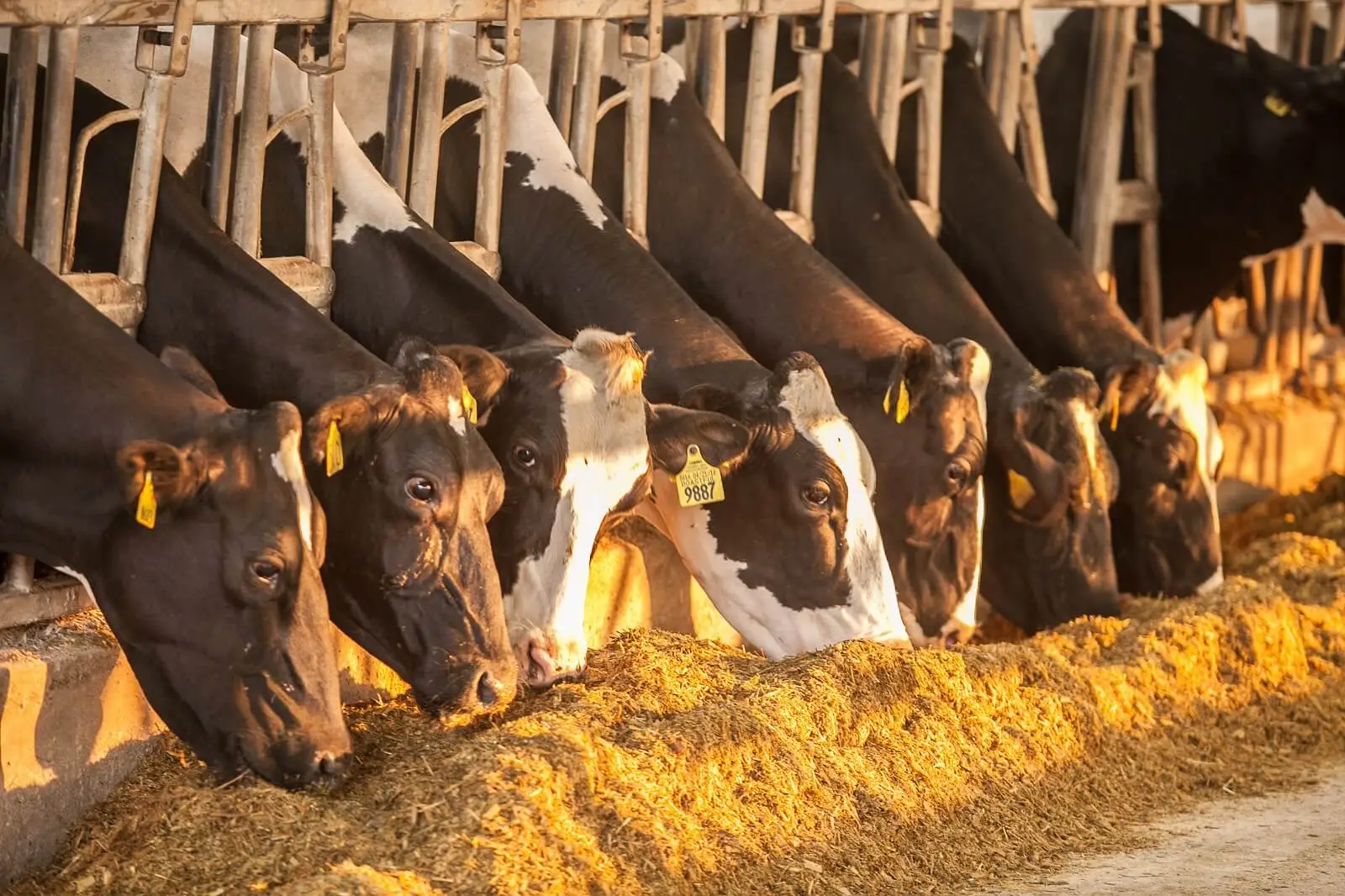Animal Welfare for Dairy Cows Is a Farmer's Priority, Here's Why
Melissa Griffin started playing the trumpet as a fourth grader and went on to earn a master’s degree in trumpet performance in college.
While she may have had Boston Symphony dreams, her career path led her back to her family’s Massachusetts dairy as a fifth-generation farmer. She occasionally breaks out her trumpet for community performances and did one memorable event before a very appreciative and well-mannered group – her dairy cows.
Griffin delighted her bovines with a rendition of Louie Armstrong’s “What a Wonderful World.” A video of the performance has amassed nearly 2 million views and earned Griffin a special appreciation befitting of cows.
“I don’t know that I’ve ever been so covered in slobber as I was that day after the video,” Griffin said with a laugh.
Other U.S. dairy farmers have enjoyed carrying a tune with their cows, and these performances exemplify the unique bond the country’s nearly 29,000 dairy farm families have with their animals. Being a dairy farmer is a 24-7-365 commitment with the nation’s 9 million milking cows. They depend on farmers for proper care related to housing, diet, veterinary oversight, and many other needs.
Dairy farmers choose to be dairy farmers because they sincerely love animals. Farmers also very much understand they would not have a livelihood and could not provide nutritious dairy foods for people around the world if their cows aren’t well cared for.
The style of care comes in many forms, and the levels of detail may surprise people.
Some farmers, for instance, will make sure their cows get a good back scratch. A few years ago, companies began producing large rotating brushes that activate when a cow approaches, providing the ultimate in back-scratch bliss. Griffin’s dairy has a brush, and she’ll never forget when it broke down.
“After we got the part to fix it, there was a long line of cows waiting to use it,” she said. “They were all fighting over it!”
Taming the Heat
Farming in triple-digit temperatures comes with the territory for Arizona dairy farmers such as Jen Millican, who recalls one day it hit 125 degrees at her farm.
“When it gets that hot, you’ll hear the local TV weathermen say how you can bake cookies in a car or fry an egg on the concrete,” Millican said.
So how does she make sure her cows stay cool during the four or so hot months in the Grand Canyon State? She and other farmers in hot U.S. climates use technological advancements that make living in extreme heat more comfortable for dairy cows.
Millican’s farm has large curtains on the sides of the cow pens that automatically rise or lower at different times of the day as the sun’s position changes for a made-in-the-shade experience.
The family also invested in a cooling system that features a series of computerized fan-like structures mounted from the ceiling. They produce a downward thrust of cool air on the cows while releasing drops of water, creating an evaporative cooling process.
“When you jump into a pool, getting wet is nice but what really cools you down is when you get out and the wind blows across your skin,” Millican said. “That’s when you get goosebumps. That’s the whole principle behind what we do with cooling cows at the dairy.”
Millican said it’s commonly 30 to 40 degrees cooler in the pens than the outside temperature.
Charles Krause also uses curtains at his dairy but his help trap heat and prevent cold winds and driving snow from entering his barn during the frigid months common in Buffalo, Minnesota, which recorded a record 110 inches of snowfall in 2022.
Krause recalls one day when he and his family headed to work in 40-below conditions. However, they quickly enjoyed a balmy 18 degrees once inside the barn. And while that may sound unenticing to humans, Krause said cows are quite comfortable in these temperatures.
“Cows are pretty hearty animals, and heat is more their enemy than the cold is,” Krause said. “You’re talking about a 1,500-pound animal that produces a lot of body heat and you put 200 of them in a barn—it’s just like when you have a lot of people over for the holidays. Your house gets pretty warm when there are 30 people in there. You have to crack open a window or turn down the air conditioning.”
The calves born at his dairy also receive special wintertime attention. Farmers in cold climates use quilted insulated calf jackets to keep the young calves warm and prevent them from getting sick.
“Anyone who’s ever put a little jacket or sweater on their dog, this is exactly like that,” he said. “It keeps them warm, healthy and comfortable.”
Calf care actually begins at farms before they even enter the world. Dairies experience the birth of their next generation routinely, so caring for the pregnant mothers entails regular monitoring and veterinary consultation.
Ohio dairy farmer Rachel Hodge keeps pregnant cows in her line of sight thanks to cameras she and husband J installed across their farm, including two in the maternity pen.
Live video – and even sound – of the cows is immediately accessed by the Hodges via their cell phones. Should they determine a cow needs attention, help is extremely close, as Rachel also is a veterinarian.
“We can see how they are doing in the middle of the night on our phone apps,” said Rachel, who is yet another musically inclined farmer who has played cello for her cows. “We can tell if she is calving or resting normally after calving, and we can determine if she is not feeling well. And because we have microphones, we can hear if it sounds like normal behavior.”
Restful Accommodations for Dairy Cows
When residents of Bridport, Vermont, head to their transfer station to drop off trash and recyclables, they’ll see an old cattle trailer on site. The trailer is long past its days of safely transporting cows, but it serves an important purpose for the Sunderland dairy farm family, who parks it there.
People are free to drop their paper and cardboard waste into the trailer, which then becomes the source of comfortable cow bedding at the dairy. Bob Sunderland said the family has been doing this practice—which happens to be good for the Earth and good for cows—for about 30 years.
The paper waste is shredded and mixed at the farm with hay and another unwanted byproduct, sawdust, to create cushy cow bedding. Sunderland says clean, comfortable stalls are one way his cows maintain their health, which is why three times a day, every day, the bedding is fluffed and freshened.
It’s the ultimate barnyard turndown service.
“Proper bedding is important to us,” Sunderland said. “Keeping their stalls as clean as we can means we don’t have many instances of mastitis [inflammation of the udder] and other health issues, and the cows love it.”
Cows Eat Like an Athlete
A proper diet is just as pivotal to a cow’s health, and many farmers rely on nutritionists to help guide the specifics of what they consume, which is no small task considering the average dairy cow eats about 100 pounds of feed a day.
Volume aside, cows and humans have some similar dietary needs. Cows require energy, protein and minerals, but they need more fiber than humans because of their four-chambered stomach, or ruminant. Ruminants have a specialized system composed of a rumen, reticulum, omasum and abomasum that allows cows to properly process and break down feed.
“When you think about what a dairy cow needs, it’s equivalent to a marathon runner who every day needs to consume a very specific diet to train for their race,” said Dr. Kaitlyn Briggs, a veterinarian who serves as director of animal health and sustainability research for Dairy Management Inc. (DMI), an organization focused on growing sales and trust on behalf of U.S. dairy farmers and importers. “This is exactly what we do for dairy cows, so we tailor their diet to meet everything they can possibly need with a variety of sources humans can’t eat.”
Indeed, cows are the ultimate up-cyclers. While they mostly consume silage, such as an entire corn plant, grass leaves or alfalfa leaves and stems, they also eat many byproduct feeds that are indigestible for humans but offer nutritional benefits to cows. This includes citrus pulp and peel from producing orange juice; cotton seeds from ginning cotton; and brewers and distillers’ grains from alcohol production, among many others. New research shows about one-third of a cow’s diet, representing anywhere from 32 to 41 million metric tons nationally each year, consists of a byproduct from crop or food company production. And while the byproducts offer a nutritious addition to cows’ diets, the U.S. dairy industry is supporting planetary health by keeping them from entering landfills.
The byproducts and silage are mixed with other feed ingredients, such as vitamin and mineral supplements, in a large blender-style wagon to create a total mixed ration (TMR), or what some farmers call a “cow casserole.” Juan Tricarico, Ph.D., senior vice president of sustainability research for DMI, said most U.S. cows are fed a TMR as opposed to grazing year-around.
“You can’t graze all year long in most regions of the world,” Tricarico said. “A TMR is designed by nutritionists to avoid nutrient deficiencies, protect animals from disease and provide all the needed nutrients for them to grow and make milk.”
Briggs says the combination of sustainably sourced feed that is good for cow health makes for a powerful chapter of dairy’s overall story. “Every year we get better and better at understanding what dairy cows need,” she said. “We’re so good at feeding her, and she’s so good at turning feed into quality milk.”
Robots in the Barn
Pennsylvania dairy farmer Donny Bartch has a new labor support system at his dairy: robots. Robotics represents another example of how technology is helping farmers be more efficient at producing milk and enhancing cow health.
Bartch built a robotic barn in late 2022. In short, it is a standalone system that allows cows the freedom to be milked when they choose without human assistance. Once cows enter the robot, sensors detect each of the udder’s four teats. The robot cleans and dries each teat before cups automatically attach to start the milking process, which takes five to seven minutes. Once done, the cows’ teats are sanitized to reduce any chance of infection before she exits to rejoin her herd mates.
While the robot greatly eases labor challenges for dairy farmers, there are health benefits for the cows too. Each cow wears a collar that allows the device to detect which member of the herd has come forward to be milked. The robot automatically dispenses feed or supplements customized to the needs of each cow. It also records factors such as weight, temperature, steps taken, milk production and how long she laid down in her stall.
Farmers have immediate access to this data via a smartphone, tablet or computer. Any shift in these figures indicates a cow may need medical attention, as it did on a recent day for Bartch.
“Just this morning, we had a cow that we were able to route to our hospital pen for an examination,” he said. “The cows can’t tell us when they are sick, so we need to pick up on these subtle differences and indicators from the robotic system. We can find these problems almost before the cow even knows she’s sick.”
Dr. Jessica McArt, a veterinarian and associate professor of ambulatory and production medicine at Cornell University, applauds the proactive nature of farmers such as Bartch. Her work at Cornell, an institution renowned for its research across several dairy industry principles, focuses on prevention of dairy cow illness and disease. She has seen how quality housing and nutrition, along with other practices, go a long way toward ensuring optimal cow health and comfort.
“One of the things I’ve enjoyed watching throughout my career is our improved ability in diagnosing and treating individual cows but really bringing it up a notch to focus on monitoring on a herd level so we can see how our preventative measures are doing,” McArt said. “We’ve done a great job preventing a lot of diseases that we used to just come in and fix.”
While technology exists to provide these measures, the goal is to make the results more immediate so a cow can let it be known she may need a medical examination.
FARM Animal Care Program
In 2009, the U.S. dairy community launched the National Dairy Farmers Assuring Responsible Management (FARM) program. The science-based program reinforces U.S. dairy’s commitment to on-farm social responsibility and is available to all U.S. dairy farmers, regardless of their herd size, region or farming style.
The FARM Program encompasses five program areas including animal care, antibiotic stewardship, biosecurity, environmental stewardship and workforce development. Each program area provides dairy farmers with resources and tools that can be used to improve best management practices.
Ninety-nine percent of the U.S. milk supply adheres to the FARM Animal Care program, which includes an evaluation tool designed to gather data to validate on-farm practices. It measures all animal care management practices and engages with industry experts such as veterinarians and nutritionists to support the culture of animal care on the farm. If necessary, FARM mandates farmers work to address any areas identified for improvement and provides a network of support to do so. Revisions to each FARM pillar occur every three years, with the animal care version set to be updated in July 2024.
“FARM relies heavily on scientifically supported best management practices and outcomes-based measurements,” said Beverly Hampton Phifer, director of animal care for FARM. “Doing so allows the program to remain relevant to the U.S.’s diverse dairy farms.”
The FARM Animal Care program is the first livestock and animal care program in the world to be recognized by the International Organization for Standardization (ISO) Animal Welfare Management standards. Additionally, some of the country’s largest companies that sell dairy, like McDonald’s, Starbucks and Nestlé, leverage FARM Animal Care as a trusted program to demonstrate to their consumers that their products are responsibly sourced.
“The advancements in the overall care, facilities, nutrition and technologies that have been adopted over the decades have all accumulated into the U.S. dairy industry being the global leader in how we care for our animals,” said National Dairy FARM Program Executive Director Emily Yeiser Stepp. “We’re able to demonstrate the vigilance our dairy farmers practice every day to ensure the best care for their animals through FARM.
“As we gather on-farm proof points and data, we know the overwhelming majority of our industry is meeting, if not exceeding, the standards we have in place for excellent animal care.”
Cow Care Spans the Generations
Anthony Agueda was on his college campus one day when his grandfather, Antonio, called him from their dairy located in California’s Central Valley. It was a poignant generational gap moment with Grandpa, 73, dialing from his flip phone, knowing his grandson, 20, could take care of an issue from a smartphone he wanted no part of.
“He called to ask what the temperature was in the barn,” said Anthony, who then opened an app that operates the farm’s cooling system. “He said, ‘it’s getting a little hot so can you turn it down?’ He’s right there at the dairy and I’m at school changing the barn’s temperature. Isn’t that crazy?”
Anthony oversees feeding the cows and will enroll at Fresno State this fall with plans to earn a degree in agriculture business. In his limited down time, Anthony posts social media updates about dairy life and how the family cares for their cows, practices rooted in the many examples set by his grandfather and father.
“I’ve been able to witness from a very early age that you always go out of your way to care for the animals,” he said. “I’ve seen them help with a calving on Christmas morning, or my dad go out in the middle of the night to the barn because something happened to a cow.”
“We don’t clock in and out; we do what needs to be done around the clock for our cows. Nobody here has ever told me, ‘You need to care for the cows.’ This is just what we do and what we have always done.”





















